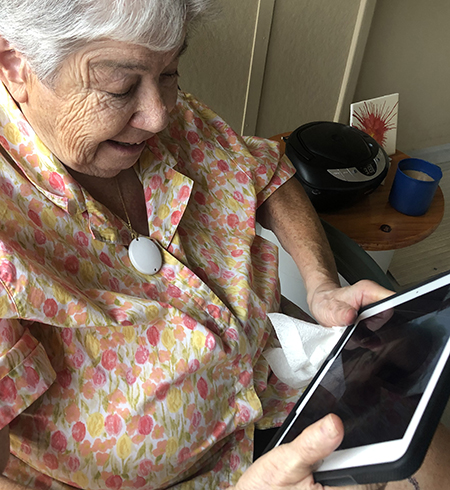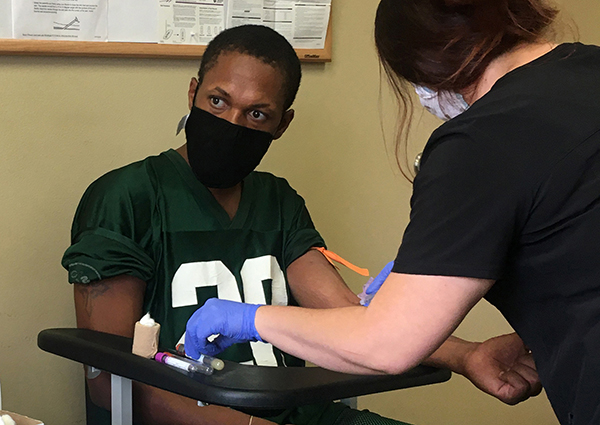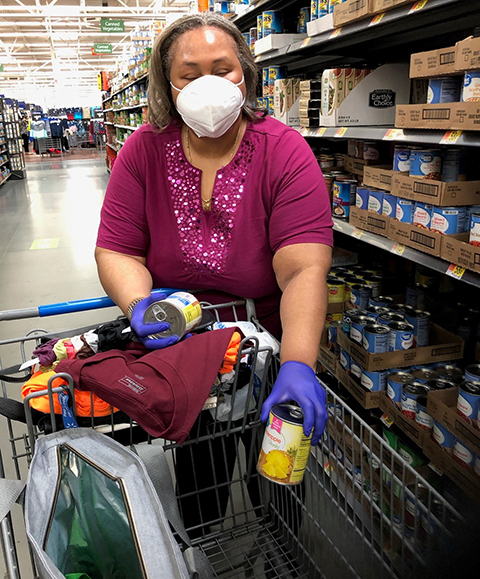During the COVID-19 pandemic, as in-person access diminished, reliance on web-based information and interfaces grew. Where these services were inaccessible, there were critical barriers to meeting one's basic needs. Risks and consequences to both physical and mental health were reported by study participants. Even where services were sought in person, exclusionary policies and procedures resulted in compromised care and higher anxiety.
Receiving Critical Information
News about the COVID-19 pandemic was generally available; however, there were some frustrating gaps, as a participant describes.
"I could read statewide tabular data throughout the pandemic, but my state also released a color-coded map and a flowchart indicating precautions to take in each zone. Press releases mentioned how many towns were in the red zone, but since neither the map nor the chart was accessible, I didn't always know when my town was in that zone or how that should affect my behavior." —Study participant
Similarly, survey respondents had mixed experiences accessing COVID-19 vaccine information. Of 395 respondents to the query about access to vaccine information, 64% agreed or strongly agreed that they had easy access, 22% disagreed or strongly disagreed, and 14% neither agreed nor disagreed. Participants frequently had someone else schedule their COVID-19 vaccine appointment (47%) while others were able to do so themselves (34%); 19% had no experience scheduling a vaccine or preferred not to answer. Of the 159 participants that reported on the accessibility of scheduling a vaccine themselves, 66% agreed or strongly agreed that the process was accessible, 15% disagreed or strongly disagreed, and 19% neither agreed nor disagreed or preferred not to answer. Often, it was a family member who scheduled the vaccine appointment, as shown in Table 3.
Table 3: Who scheduled the COVID-19 vaccine appointment for you? (n=217)
| 47% | A family member |
| 18% | A healthcare provider |
| 17% | A friend |
| 7% | An individual at an agency or organization for the blind |
| 1% | An individual at an agency or organization for older people/senior citizens |
| 10% | Other, please describe. |
"Many of the county and state websites were completely inaccessible to screen reader users. The online system to sign up for vaccines was so overloaded that it was [even] impossible for nondisabled people to use them to book appointments. The website would time out before any useful information was given and there was not enough time to even schedule an appointment when one was open." —Study participant
"I think it is assumed that someone else is available (friend, family, whoever) to help/look out for us. Some of us have people to do that. Many people do not. I would rather not have to ask someone to help me but sometimes it is just easier/quicker. It doesn't solve the bigger problem." —Study participant
Challenges to Managing Healthcare
Survey respondents expressed considerable concern about barriers to obtaining health care and supplies and frustration with protocols that did not take into account patients or customers with a visual impairment. In addition to the aforementioned requirement to wait outside a facility until called, participants found it difficult to complete paperwork, navigate physical spaces on their own, and access telehealth.
"Healthcare is so far from being fully accessible. From inaccessible forms and websites to the lack of accessible buildings and medical equipment, [the lack of accessibility] causes problems with medical care for people with disabilities. You would think the medical field would understand" —Study participant
Of the 202 participants that responded to a question about getting needed healthcare supplies or prescriptions, 43% reported having challenges. Barriers included difficulty getting in touch with the doctor's office or pharmacy, transportation challenges, and inaccessible websites and prescription labels. Fortunately, as a few respondents noted, over time, delivery and mail options expanded and delivery fees were waived by some pharmacies.
In reply to the question "When you, your child, or someone whose healthcare you assist with were receiving medical care, were you allowed to have someone with you who would normally assist you with accessibility issues in a medical setting?" 25% of the 356 respondents indicated that this was not allowed.
"I had to rely more on the medical staff. They didn't understand all of the issues involved in being visually impaired. Some gave me a hard time filling out forms. They were upset that they had to fill them out for me." —Study participant
Telehealth became more commonplace during the pandemic. Use of telehealth was attempted by 70% of survey respondents during this period and 57% of those 330 respondents reported having accessibility challenges with telehealth platforms. Table 4 depicts accessibility challenges reported by participants.
Table 4: Select any of the accessibility challenges you experienced with Telehealth platform(s). (n=188)
| 77 | I had difficulty navigating the platform to make an appointment. |
| 60 | I was not able to independently log in. |
| 59 | I was not able to position the camera in a way my healthcare provider needed me to. |
| 52 | I was not able to read information provided through the system, e.g. chat. |
| 52 | Buttons were not properly labeled to be read by my screen reader. |
| 49 | I was not able to privately communicate with healthcare professionals. |
| 43 | I was not able to electronically sign documents. |
| 24 | The platform was not available on my preferred electronic device. |
| 28 | Other, please describe. |
| 1 | I prefer not to answer. |
"My doctor had to end up using FaceTime to communicate with me because I was not able to communicate with her via the telehealth platform." —Study participant
This was identified by some as a problem when relying on telehealth for mental health services. Fifty-seven percent of respondents reported experiencing changes in their mental well-being during the COVID-19 pandemic, and 12% of those 255 respondents reported that they did not have access to the resources necessary to support their challenges with mental well-being.
"I had more anxiety [with] COVID-19, testing, vaccination, and lockdowns. The counseling I received helped me ease my anxiety. —Study participant
"[There needed to be] more telehealth appointments, especially for mental health. I live in an area without public transportation of any kind, so travel to appointments can be exceedingly difficult. —Study participant
Concerns About Obtaining Food
The Flatten Inaccessibility study found that 59% of respondents had concerns about having access to food, meals, and supplies as a result of the COVID-19 pandemic. Many of the respondents used a variety of means, including a friend or family member, local delivery service, or online app, to access these necessities. As COVID-19 progressed, all of these lines of access became compromised, and the results of the Journey Forward survey showed that concern was warranted. Almost half (45%) of all survey participants reported that they experienced challenges with having food, groceries, or supplies delivered during the pandemic. Accessibility problems with online ordering apps were reported by more than 40% of survey participants. In addition, a number of other challenges, outlined in Table 5, were experienced.
Table 5: Please check any of the additional challenges that you experienced while having food, groceries, or supplies delivered. (n=204)
| 89 | All the delivery times were filled. |
| 70 | The added cost of delivery meant I had to do without something else to afford the cost of delivery. |
| 64 | I was able to place my order, but was not notified when my food/groceries arrived. |
| 42 | The food/grocery service did not deliver in my area. |
| 41 | The company would not accept my SNAP benefits. |
| 14 | I could not afford delivery. |
| 10 | Other |
| 4 | I prefer not to answer. |
Barriers to Independent Voting
Eighty-one percent of respondents participated in the November 2020 presidential election and 67% of those voted by mail-in ballot. In the open-narrative question associated with voting experience, 20% of survey participants reported needing to request sighted assistance to complete their ballots, compromising their ability to vote independently and privately.
"Our state government announced an accessible PDF that could be filled out, printed, and returned in an accessible envelope to our local town hall. However, my town hall was not informed of the procedure and refused to accept the PDF I filled out. I found out early enough that I was able to have a friend help me fill out the normal mail-in ballot, but I was disappointed that our secretary of state had not communicated with my town hall to help me vote independently." —Study participant
As the Journey Forward study shows, issues identified in Flatten Inaccessibility at the start of the COVID-19 pandemic continued unresolved over an extended period, including ongoing problems with transportation, maintaining safety, and access to medical care and supplies, food, and independent voting. As the survey responses illustrate, participants found it frustrating and sometimes unsafe when they encountered accessibility problems and exclusionary processes.


